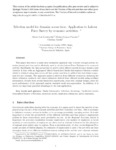Selection model for domains across time: application to labour force survey by economic activities

Use este enlace para citar
http://hdl.handle.net/2183/34439Coleccións
- Investigación (FIC) [1683]
Metadatos
Mostrar o rexistro completo do ítemTítulo
Selection model for domains across time: application to labour force survey by economic activitiesData
2021-03Cita bibliográfica
Lombardía, M.J., López-Vizcaíno, E. & Rueda, C. Selection model for domains across time: application to labour force survey by economic activities. TEST 30, 228–254 (2021). https://doi.org/10.1007/s11749-020-00712-4
Resumo
[Abstract]: This paper introduces a small area estimation approach that borrows strength across domains (areas) and time and is efficiently used to obtain labour force estimators by economic activity. Specifically, the data across time are used to select different models for each domain; such selection is done with an aggregated mixed generalized Akaike information criterion statistic which is obtained using data across all time points and then is split into individual component for each domain. The approach makes a selection from different estimators, including the direct estimator, synthetic and mixed estimators derived from different models using auxiliary information. Results from several simulation experiments, some with original designs, show the good performance of the approach against standard small area approaches. In addition, it is shown the important practical advantages in the real application.
Palabras chave
Akaike Information Criterion
Bootstrap
Fay-Herriot model
Generalized Degree of Freedom
Monotone model
Small area estimation
Spline regression
Bootstrap
Fay-Herriot model
Generalized Degree of Freedom
Monotone model
Small area estimation
Spline regression
Descrición
This version of the article has been accepted for publication, after peer review and is subject to Springer Nature’s AM terms of use, but is not the Version of Record and does not reflect post-acceptance improvements, or any corrections. The Version of Record is available online at: http://dx.doi.org/10.1007/s11749-020-00712-4
Versión do editor
ISSN
1863-8260





